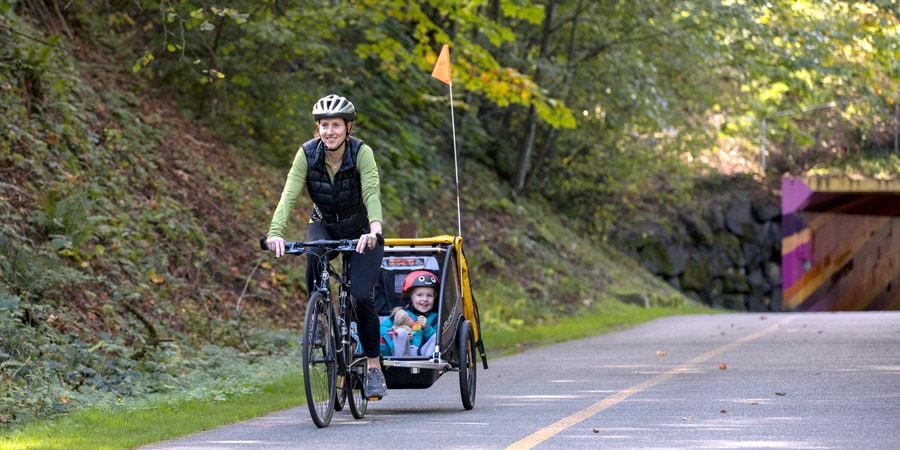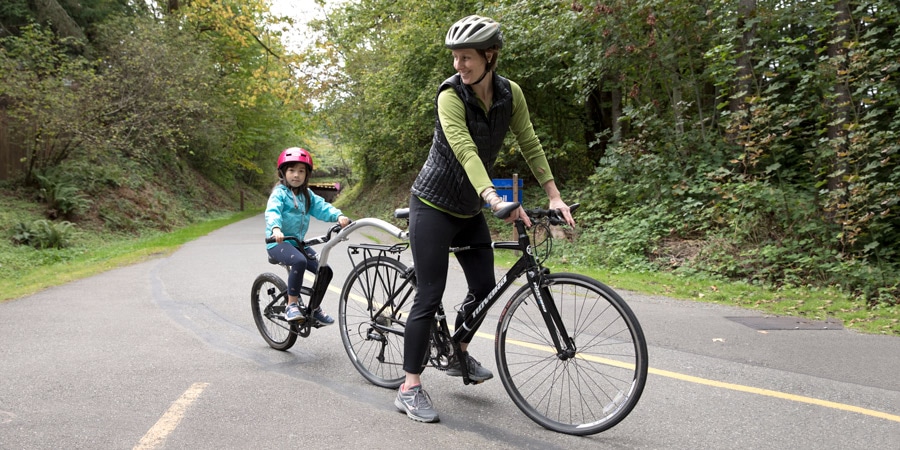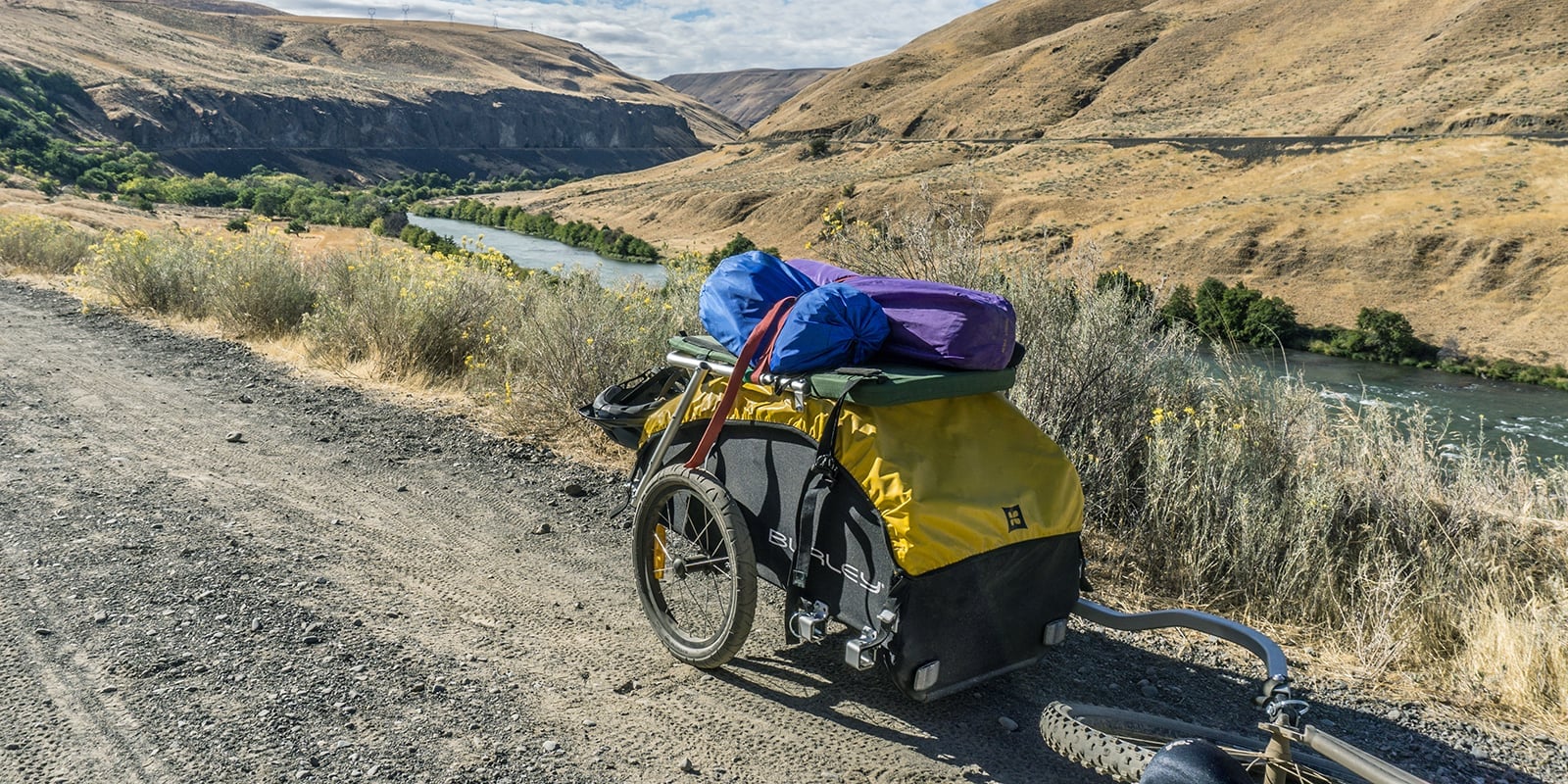Bike trailers make it easy to carry cargo on your next cycling adventure. Whether you're hauling extra camping gear or want to take your child or dog along for a ride, bike trailers keep the weight off your back or bike for a more comfortable ride.
When choosing a bike trailer, consider how you plan to use it. Do you want to haul gear for a long-distance bike tour? Carry groceries around town? Tow a child or pet to the park? Whichever trailer you choose, remember that you will be towing the weight of the trailer in addition to the weight of your child or cargo.
In this article, we'll cover three types of bike trailers:
- Bike cargo trailers: Trailers for cargo are ideal for hauling heavy or bulky items. Some convert to wheeled carts for easy use at a grocery store.
- Bike trailers for kids: These trailers give your child a comfortable place to rest on your family bike ride. Enclosed trailers can hold one or two kids who aren't able to pedal on their own. With trailer bikes (sometimes called "tag along bikes"), a child has the option to pedal on their own.
- Bike trailer for dogs: A dog trailer lets you tow your four-legged friends on bike adventures.
Bike Cargo Trailers
A cargo trailer lets you carry bulky gear on long bike tours or jaunts about town. Because the weight is on its own wheels, carrying a load in the trailer may feel lighter than carrying the weight on your bike.
When you arrive somewhere and want to leave your gear behind, cargo trailers are easy to unhook quickly. Some cargo trailers, once detached, can be used as wheeled carts; those are ideal for rolling into the farmers market or grocery store, or wheeling straight into the house to unload.
If you're planning to haul gear on rough roads or trail, consider a cargo trailer with suspension. Suspension helps keep your gear from being bounced around. Also, it helps the trailer wheel(s) stay in contact with the ground, which makes your load easier to maneuver, with less stress on you, your bike and the trailer.
Cargo trailers are typically available with one or two wheels:
- Single-wheel cargo trailers: Single-wheel trailers generally are more nimble with less drag on the road than two-wheel trailers. On technical terrain like single track, they're easier to maneuver. On a narrow track, a single-wheel trailer will roll better than a two-wheel trailer.
- Two-wheel cargo trailers: Two-wheel trailers keep your load balanced and stable, which can make loading and unloading easy. And, you won't have to stress about perfectly balancing your load when you're packing. They are typically wider than single-wheel trailers so may require more room to turn.
Bike Trailers for Kids
Bike trailers for cycling with kids include enclosed child trailers and trailer bikes. In an enclosed trailer, your child is seated and does not pedal. These trailers can hold one or two children. Meanwhile, trailer bikes, also known as "tag along bikes," are good for kids who may want to pedal but aren't strong or confident enough to do so on their own yet.
Your child should always wear a helmet when they are riding in a bicycle-towed trailer. Not only will this protect your child, but it will also help them develop good habits. Also, make sure the helmet fits and is worn correctly. To learn more about proper sizing and fit, see our article on How to Choose a Bike Helmet.
Child Bike Trailers

Bicycle trailers for hauling kids typically attach to the rear hub of your bike and allow your child to sit back and relax while you pull them along. They're a good option for kids from about 1 to 6 years old. Many offer conversion options that allow you to use them as a stroller, jogger or ski trailer.
They typically have a fabric top, bottom and sides with aluminum bars for structure and protection, and a zip door about the width of the front of the trailer. The door will typically have a mesh window under a plastic window for venting, keeping out insects and offering weather protection.
Bicycle trailers offer greater protection for your child than a seat mounted to the frame of your bike. If your bike falls over, a child in a will fall up to three feet before they hit the ground. Child trailers have full roll cages to help protect your passenger(s) in the event of a crash.
If you are pedaling with a young child, always support their head. Some trailers offer stabilizing pillows or other head support. The industry standard is to wait until a child is one year old before allowing them to ride in a bike trailer. A child should be able to sit upright unattended and hold their head up while wearing a bicycle helmet. Always check with your pediatrician to confirm your child is ready to be towed in a trailer.
Child Bike Trailer Features
Harness: Inside, an enclosed trailer has a seat with a harness system—similar to a child car seat—for each passenger. On more expensive models, the seat reclines for a more comfortable resting position—good for napping while riding.
Storage pockets: Most trailers have interior storage pockets and snack tray for your child's toys, games and food. Many have storage compartments for adults, so you can stash your keys, wallet and a diaper bag or backpack.
Suspension: Some trailers have suspension to smooth out bumps in the road.
Seating capacity: Some are designed to carry only one child, while others can hold two.
Parking brake: All convertible enclosed child trailers have a parking brake to keep the trailer from rolling away. The most secure ones lock the hub. On lower-priced trailers, the brake may be a bar that presses on one of the tires, which may not be as secure.
Conversion kits: Many bicycle trailers for kids either come with a spare wheel so that you can convert for foot travel on the fly—no fumbling with extra parts required. Or you can buy accessories to convert the trailer from bike-towed trailer to jogger, stroller or ski trailer.
Trailers that convert either come with a handle—also called a handlebar—on the back, or a rear-mount handle is available as an accessory. Check each model's specs to see if the manufacturer makes a compatible conversion kit. (Less expensive trailers may not convert.) If a trailer comes with a rear handle, it may fold away when you're biking, not strolling/jogging. In some trailers, the handle folds to act as a second roll bar.
A strolling kit typically includes a single swivel wheel that attaches to the tow bar. A jogging kit typically includes a single larger wheel. And, a ski conversion kit has a pair of skis that attaches to the trailer.
Retractable sunshades and windows: Some trailers have retractable sunshades and plastic/mesh side windows so that your child can look out as you ride and get good cross ventilation. Some trailers use UV-rated plastic and/or fabric to help protect your kids from the sun's rays. High-end trailers may have bowed sides to give children more interior space.
Trailer Bikes

Trailer bikes give kids the option to pedal and really feel like they are part of the ride. A trailer bike is a good option for kids about 4 to 7 years old who want to pedal along with you, but who may not be strong or confident enough to do so on their own bike yet.
Trailer bikes have a single wheel, like the rear wheel of a bicycle, and are available in upright and recumbent configurations. Upright trailer bikes best simulate riding a regular bike, while recumbent setups give kids the option to pedal, play or doze.
Many trailer bikes can be adjusted so they can fit different passengers or fit your child as they grow. Some have very basic adjustments, such as a seat that goes up or down, while others can be fully dialed for a performance fit.
Trailer bikes have either a single speed for riding on flat terrain or a multispeed drivetrain that makes it easier to climb hills. A drivetrain with gears also helps your passenger learn to shift.
Trailer bikes can carry a maximum weight of 65-85 pounds. Compare trailers at REI.com to make sure your child can grow into the trailer you choose.
For more information on introducing your child to biking, see our article, Cycling with Young Kids.
Bike Trailers for Dogs
Cyclists who want to take their dogs (or other pets) along for adventures may consider getting a dog trailer. Why get one? Dogs that enjoy tagging along on your excursions may not be able to keep up with your pedaling or they may tire out on longer rides. A dog trailer is typically enclosed, has no seats and offers features such as an interior leash attachment.
Bike Trailer Accessories
Gear bags: Many cargo trailers have an assortment of compatible bags to keep your gear clean, dry and organized.
Hitch arm/mount: Some gear trailers have swappable attachment systems to make them compatible with different rear axles, wheel sizes and brake configurations.
Additional bike mounts: Depending on how your trailer attaches to your bike, you may want additional bike mounts so that you don't have to switch a single mount from bike to bike.
Bike Trailer Attachment Systems
Whether for you child, gear or pet, bike trailers connect to your bike in different ways. Trailers commonly mount to your bike's seat post or the rear axle of the bike. Check to make sure that the trailer you're considering is compatible with your bike's brakes, axle and drivetrain.
In many cases, you'll be able to connect the trailer to your bike right out of the box. For example, many bikes with standard quick-release skewers (that's the rod that attaches the wheel to your bike) are compatible with many trailers.
With some bikes, it can be trickier to connect a trailer. You may need an adapter or aftermarket accessory part to make the attachment work. For example, bikes with hooded dropouts, thru-axles or with internal gear hubs may require an adapter. Consult the trailer manufacturer for trailer and bike compatibility. Thule and Burley both provide guides to help you sort it out.
Most trailers easily detach in seconds, so when you want to ride without the trailer, it's easy to remove it.
Bike Trailer Storage
Before you buy, consider what space you have for trailer storage. Some kid trailers pack down flat and have removable wheels for easy storage, while others store fully assembled. Some come in easy-to-carry bags that can also be used for gear transport.
Trailers with smaller wheels are more compact and easier to store. However, larger wheels absorb bumps in the road better than small wheels, with less jostling of your passenger or gear. Most child trailers have 20" wheels. Cargo and pet trailers typically have 16" wheels.
